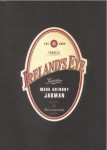 |
Irelandís Eye
by Mark Anthony Jarman
Anansi, 2002
Reviewed by Michael Bryson
Read
the TDR Interview with Mark Anthony Jarman
A friend tells me he went to a writing workshop and the teacher used a Mark Anthony Jarman short story as an example of how NOT to write a short story. "Jarman is only interested in sentences," the teacher said. "Jarman isnít interested in plot."
Hey, now, I said. How about that story "Cougar" (from
19 Knives), about a guy all set to kill himself until he confronts a cougar in the forest and decides life is worth living after all? "Thatís a plot," my friend said. Sure, I said. Sure, it is.
Jarmanís memoir/travel book, Irelandís Eye, has a plot, too, though my friendís workshop teacher might miss it. Because Jarmanís sentences do dazzle. And his narrative wanders. Like a walk through the Irish countryside, one might say. Though itís more like a walk through memory Ė or a walk through time.
A plot summary: In 1981, Jarman, raised in Alberta, visits Ireland, his motherís birthplace and still home to hers and his extended family. Twenty years later, Jarman visits again. He has changed. The extended family has changed. His mother is slipping into an Alzheimerís dementia. Jarman is tracking the story of his maternal grandfather, who drowned in a Dublin canal on the same day as the one-time IRA-general Michael Collinsí funeral, one of the largest in Irish history.
Most of the narrative tension in Irelandís Eye comes from Jarmanís quest for answers about his grandfatherís drowning. On a secondary level is the story of two visits to Ireland twenty years apart. Through this filter (compare and contrast), Jarman interprets Ireland, his mother, his grandfather, himself. What Jarman comes up with, following Yeats (is there an Irish nose more prescient?), is a centre that cannot hold.
What Jarman learns about his drowned grandfather is that his grandfather drowned. Some readers might find this non-revelation dissatisfying, but some of us expect more from Jarman than lock, stock and barrel solid answers: We expect a narrator full of questions that remain open. Tough questions, asked by a seeker never satisfied. Turn to your dictionary, look up "verisimilitude." The Concise Oxford says: "Appearance of being true, semblance of actuality." Jarman is too post-modern to give us verisimilitude 19th-century style (ye olde capital-R Romantic style) capital-T Truth, which we already knew about him (from the fiction, I mean; that "plotless," plotful, playful language party). Jarmanís verisimilitude is something else; itís the semblance of actual feeling of actuality weíre more likely to be actually feeling. What happened? What does it mean? What the bloody hell is all of this about, then?
Is it Ireland or it is Jarman? Is it the object or the eye?
In A Colder Eye: The Modern Irish Writers, Hugh Kenner discusses "Irish facts," and in Kennerís thesaurus "Irish" shares space with "slippery," "unreliable," "fabricated." Those Irish and their storytelling! How proud they are of their narrative-making skills! How disinterested they are in dry bones history! Well, not all of them surely, not all Irish are fancy pants liars, but Kennerís point is that Ireland then and now (100 years ago, 30 years ago) was and is an oral culture Ė and oral cultures value a good tale over the scholarly accuracy of dusty archival records. Jarman waltzes into his Irish adventure like the Canadian he is, earnestly seeking to nail down the past, but the past wonít be nailed down. His relatives tell him contradictory stories: All true! He finds some facts in microfiched newspapers: His grandfather drowned in a canal. He goes off in search of the canal, the canal isnít where it is supposed to be, he finds the right canal: There it is, the deadly water, it does not speak.
Jarmanís mother is Irish, his father English. Jarman is Canadian with a quarrelling Anglo-Irish soul. The English trampled and oppressed the Irish for centuries. When the English left, the Irish trampled each other in a bloody civil war. Michael Collins was its most prominent victim. Jarmanís grandfather worked for Guinness, which had long-held links to the English. The home Jarmanís mother grew up in, however, was a safe house for militant Republicans. It was a murderous time. Was Jarmanís grandfather murdered? Jarman never asks this question directly, but it leaps to the readerís mind, so thickly does Jarman swamp his narrative in innuendo. This reader wanted the answer to be Yes and admits to some let-down that the authorís research didnít reveal more definitive results. Maybe we need a Kenner formation: "Irish results." The centre cannot hold. This is verisimilitude, too.
Irelandís Eye tells the tale of a changed and changing Ireland. It tells the tale of a changed and changing Jarman. The author is enough of a post-modernist to foreground his subjectivity. In 1981, he visited Ireland, hung out with his cousins, chased girls. Twenty years later, he visited Ireland, hung out with his cousins, chased his dead grandfatherís ghost. Irish real estate prices entered the new millennium tanked on jet fuel. Irelandís entry to the European Union brought with it bags of European money. Ireland is losing its distinct society. Guinness is conquering the world. Kitschy North American Irish-style pubs are uprooting the real thing, which are anything but kitsch, though they are becoming that now.
One of Jarmanís cousins dies of AIDS, another, a cop, talks about Dublin kids and their heroin. It is a bloody time with death all around. Jarmanís mother slips into her Alzheimerís dementia, lives on, but no longer knows her own son. Does Jarman know Ireland? Is Ireland knowable? Ireland can be seen; Jarman sees it; Irelandís Eye is the delicious result.
Michael Bryson is the publisher/editor of The
Danforth Review. |